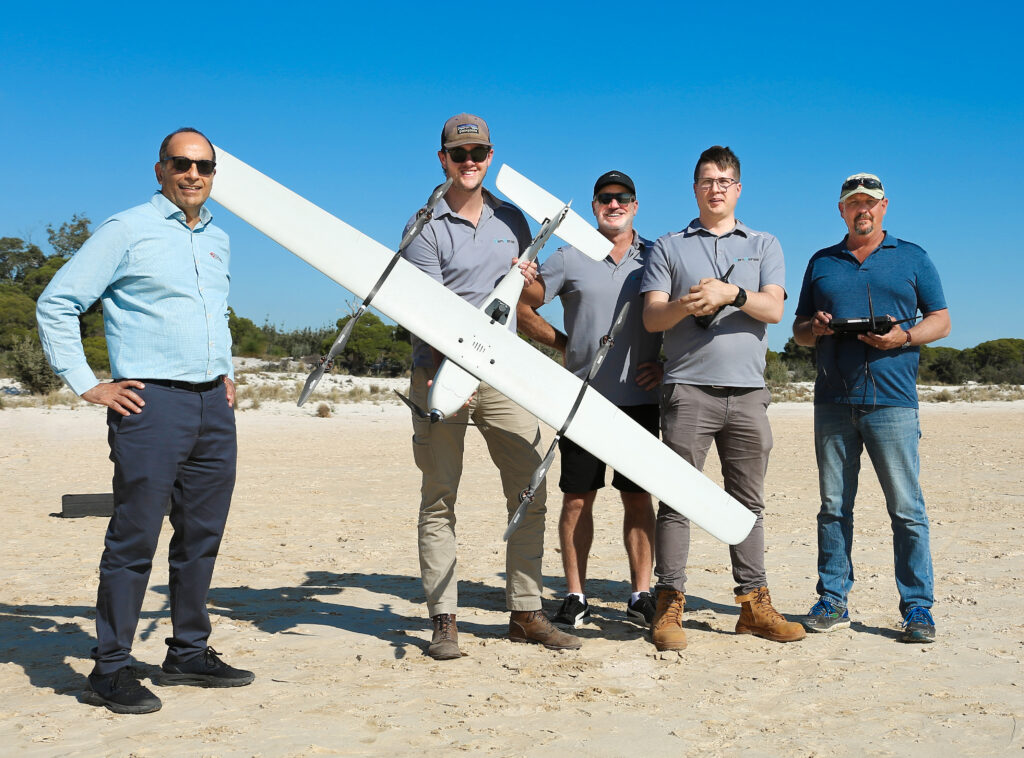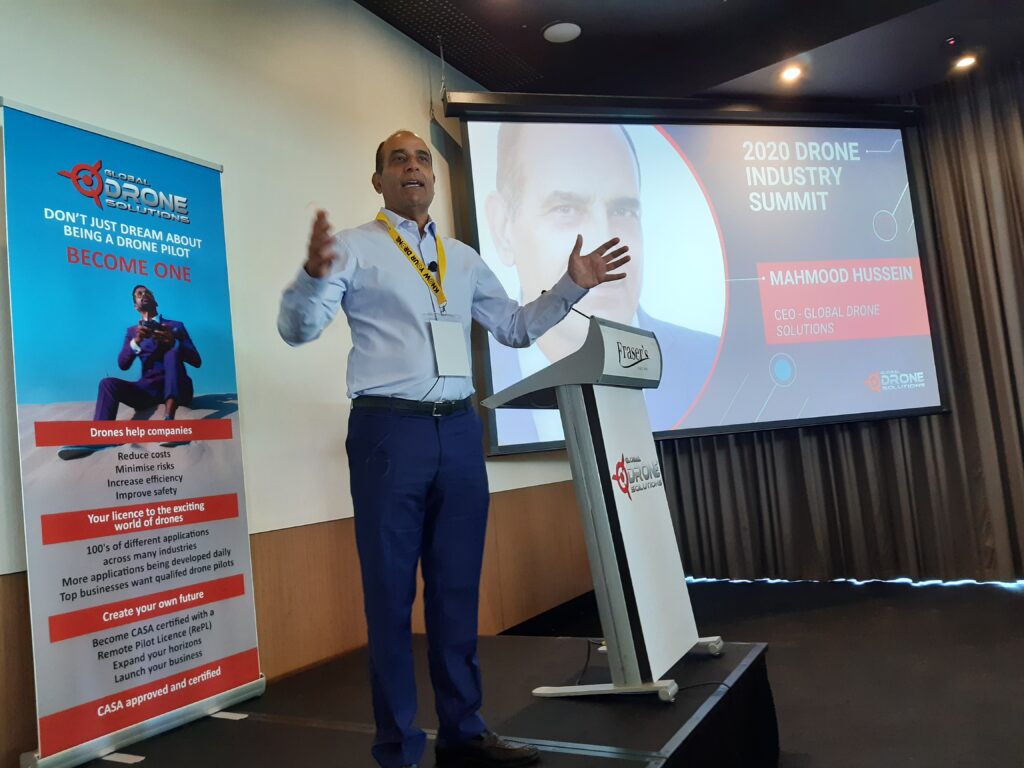In the sprawling landscapes of Australia, where vast mining operations stretch beyond horizons and energy infrastructure spans thousands of kilometres, a technological transformation is reshaping how industries operate. At the centre of this evolution stands Mahmood Hussein, whose journey from traditional energy and aviation sectors to drone technology leadership exemplifies how strategic vision can create meaningful careers in emerging fields.
Since founding Global Drone Solutions on January 2nd, 2016, Mahmood has built Australia’s premier drone training enterprise, having certified over 7,000 pilots and established partnerships with industry giants including BHP, Rio Tinto, and Chevron. But behind these impressive achievements lies a deeper story about purpose-driven entrepreneurship and the power of education to transform both individual lives and entire industries.


“After decades in energy, training, and aviation, I witnessed drones rapidly changing how industries operate,” Mahmood reflects. “It was never just about obtaining a licence. It was about creating sustainable careers and building confidence in emerging technology that could fundamentally improve safety and efficiency.”
This philosophy has driven Global Drone Solutions beyond basic certification to become a comprehensive workforce development partner, addressing the critical skills gap in an industry projected to reach $179.3 billion globally by 2030.
The Integrated Business Ecosystem: Three Companies Driving Workforce Transformation
Mahmood’s entrepreneurial vision extends beyond drone training through three interconnected businesses that collectively address the complex challenges of technological adoption in traditional industries. Global Drone Solutions delivers CASA-approved drone pilot certification with specialised modules in photogrammetry, LiDAR, thermography, and surveying. Global Energy Learning Solutions provides comprehensive training and recruitment services to the global resources and energy industries, backed by over 150 years of combined industry knowledge. Industrial Metaverse revolutionises workplace learning through virtual reality training solutions that enhance knowledge retention and practical skill development.
The synergy between these ventures reflects Mahmood’s holistic understanding of successful technology integration. Rather than viewing drone technology in isolation, he recognises that meaningful adoption requires comprehensive workforce development, rigorous safety protocols, and innovative training methodologies.
“What unifies these businesses is a shared purpose: using education and technology to create opportunity,” Mahmood explains. “Whether training a drone pilot, developing safety protocols for mine workers, or creating immersive learning experiences, we help people work smarter, safer, and with greater confidence.”
This integrated approach has proven particularly valuable in industries where technological adoption must balance innovation with stringent safety requirements. The ecosystem approach has been especially effective with enterprise clients like Chevron, BHP, and Rio Tinto, who require partners capable of managing complex, multi-faceted technology implementations.
Navigating Regulatory Complexity: Strategic Solutions to Early Challenges
The founding of Global Drone Solutions in 2016 coincided with a period of rapid regulatory evolution, as the Civil Aviation Safety Authority (CASA) developed frameworks for commercial drone operations. This timing created both unprecedented opportunity and significant operational challenges.
“The early days presented unique regulatory and market challenges,” Mahmood recalls. “CASA regulations were still evolving, creating uncertainty about compliance requirements. We invested heavily in regulatory relationships and participated in industry consultations to help shape standards.”
Operating with limited resources while maintaining strict CASA compliance standards required exceptional strategic focus. The company’s approach involved systematic market education, as traditional industries were initially sceptical about drone technology’s return on investment and safety implications.
“We faced significant industry scepticism about ROI and safety,” Mahmood explains. “We addressed this through comprehensive demonstration events and pilot programs that allowed organisations to test our solutions with minimal risk.”
The breakthrough came through consistent delivery of high-quality training, hiring expert instructors with deep industry knowledge, and actively listening to client needs. This commitment to excellence gradually built the credibility that would establish Global Drone Solutions as Australia’s leading drone training provider.
“Growth was methodical rather than rapid, but we focused on delivering measurable outcomes,” Mahmood notes. “Staying true to our mission of creating meaningful careers and improving industry safety helped us build credibility and become the trusted partner we are today.”
Purpose as the Ultimate Driver: Building Legacy Through Lives Transformed
What sustains an entrepreneur through the uncertainties of building businesses in rapidly evolving technology sectors? For Mahmood, the answer lies in purpose and legacy rather than purely commercial considerations, with motivation drawn from the tangible impact on individual lives and broader industry transformation.
“I am motivated by purpose and legacy. I want to create something that outlives me, something that genuinely changes lives,” he explains. This motivation becomes tangible through the diverse range of individuals who have discovered new career paths through drone training programs, from Indigenous rangers and military veterans to young people seeking their first professional qualification.
“Technology moves rapidly, but what matters most to me is the people we help and the sustainable opportunities we create along the way,” Mahmood reflects. This people-first philosophy influences every aspect of how Global Drone Solutions operates and measures success.
The company’s mentorship programs pair new graduates with experienced professionals who provide ongoing guidance on career development and business opportunities. This approach recognises that many students come from diverse backgrounds and may need encouragement and support beyond technical training.
“Many students come from diverse backgrounds and need more than technical training. They need someone to believe in them and provide ongoing support as they build confidence in emerging technology,” Mahmood emphasises.
Staying Ahead Through Strategic Innovation: Technology Leadership in Practice
Maintaining innovation leadership in drone technology requires more than following industry trends. Mahmood’s approach combines systematic curiosity, strategic partnerships, and continuous learning with rigorous practical application testing to ensure innovations solve real operational problems.
“Staying ahead requires systematic research and strategic partnerships,” he explains. “We’ve established dedicated R&D capabilities with teams focused on emerging technologies, regulatory developments, and market trends. We recently created an AI department and recruited specialised staff to ensure our businesses remain at the forefront of technological advancement.”
This methodology has enabled Global Drone Solutions to develop comprehensive VR training capabilities, launch advanced courses in photogrammetry, LiDAR, thermography, and surveying, and integrate artificial intelligence into training systems. The key insight driving these innovations is that technology adoption must address specific operational challenges.
Strategic partnerships with universities, research institutions, and technology companies provide early access to emerging technologies. The company’s relationships with major industry clients like BHP, Rio Tinto, and Chevron also drive innovation by presenting real operational challenges that push the development of novel solutions.
“Our partnerships with CASA, Defence, and major industry players provide crucial insights into regulatory developments and emerging operational needs,” Mahmood notes. “This collaborative approach ensures that our innovation efforts align with both technological possibilities and practical requirements.”
“Innovation requires solving real problems and staying ready for what comes next,” Mahmood emphasises. “We don’t adopt new technology just because it’s available. We focus on innovations that genuinely improve safety, efficiency, and career opportunities.”
The Industrial Game Changer: Why Drones Transform Operations Beyond Efficiency
The transformative impact of drone technology across industries like mining, energy, and telecommunications extends far beyond operational efficiency improvements. Mahmood’s perspective emphasises how drones fundamentally change risk profiles, decision-making capabilities, and the speed at which organisations can respond to operational challenges.
“Drones address three critical challenges simultaneously: safety, efficiency, and data quality,” he explains. “In mining and energy sectors, they eliminate the need for personnel to enter dangerous areas or work at height. In telecommunications, they make tower inspections safer and significantly quicker while providing more comprehensive data.”
The real-time decision-making capabilities enabled by drone data collection represent a paradigm shift from reactive to proactive asset management. Operations that previously required days of planning, safety preparation, and execution can now be accomplished in minutes, with greater precision and dramatically reduced risk exposure.
“What used to take days now takes minutes, all with substantially less risk and greater precision,” Mahmood notes. “Drones aren’t just operational tools—they’re essential infrastructure for any forward-thinking business serious about safety and efficiency.”
In mining applications, Rio Tinto’s implementation has achieved a 94% reduction in lost production time for ore crushers through predictive analytics enabled by drone data collection. The energy sector has seen equally impressive results, with Chevron’s drone program achieving up to 33% efficiency gains and 50% cost reduction while significantly improving worker safety.
For telecommunications infrastructure, drones are revolutionising management across hundreds of thousands of cell tower sites. Traditional inspections cost between $1,000-$4,000 per site and require dangerous climbing work. Drone inspections dramatically reduce costs while eliminating fall risks and radiation exposure.
Differentiation Through Comprehensive Capability Building: The Global Drone Solutions Advantage
In a marketplace with numerous drone training providers, Global Drone Solutions has established clear differentiation through comprehensive capability building rather than basic certification processes. This approach recognises that sustainable careers require more than technical competency and regulatory compliance.
“What sets us apart is our focus on real outcomes and long-term career success. We go beyond ticking regulatory boxes to build confident, job-ready pilots who can immediately contribute to operational objectives,” Mahmood explains.
This comprehensive approach combines CASA-approved training with deep industry knowledge, flexible learning options, expert instructors with extensive operational experience, and nationwide coverage. The addition of custom-built VR simulators demonstrates ongoing commitment to innovative training methodologies that enhance learning effectiveness.
Beyond individual certification, Global Drone Solutions helps clients build and manage entire drone programs, from initial strategy development through implementation and ongoing optimisation. This consultative approach positions the company as a strategic partner rather than simply a training provider.
“We are more than a training company. We are a trusted partner in comprehensive drone capability building,” Mahmood states. “Our clients rely on us not just for certification, but for ongoing support, strategic guidance, and access to the latest technological developments.”
The company’s industry-specific approach includes specialised modules developed from direct experience with major industry players. Mining clients receive comprehensive training in geological surveying and mining-specific safety protocols. Energy sector training focuses on infrastructure inspection and thermal imaging. Telecommunications modules address cell tower inspections and safety compliance.
Evolution and Future Trajectories: From Niche Applications to Essential Infrastructure
The evolution of drone applications over the past five years illustrates both the rapid pace of technological advancement and the expanding scope of practical applications across traditional industries. Mahmood’s observations reveal how the sector has matured from specialised niche applications to central operational tools.
“Five years ago, drones were primarily used for photography and basic visual inspections. Today, they are central to asset management, comprehensive mapping, thermal imaging analysis, and emergency response coordination,” he explains. “The shift represents a fundamental change in how organisations approach operational challenges.”
Future developments will likely centre on autonomous flight capabilities, swarm operations for complex coordinated tasks, and AI-powered data processing that transforms raw information into actionable insights. The integration of drones into daily operational workflows rather than occasional special applications represents the next phase of industry evolution.
Regulatory improvements will play a crucial role in unlocking advanced applications like Beyond Visual Line of Sight (BVLOS) operations, which will further expand the practical applications of drone technology. Environmental monitoring will grow significantly, driven by carbon credit markets and net-zero frameworks.
“In the future, I see substantial growth in autonomous flight operations, swarm intelligence for coordinated multi-drone tasks, and AI-powered data processing that provides real-time operational insights,” Mahmood predicts. “Drones will be more deeply integrated into daily workflows across all industries.”
The “Drones as a Service” market is projected to reach $179.3 billion by 2030, democratising access to aerial technology for organisations that cannot justify internal drone programs. This trend will create new opportunities for certified pilots while expanding the overall market.
Real-World Transformation: The Indigenous Rangers Success Story
One of the most compelling examples of drone technology’s transformative potential involves Global Drone Solutions’ comprehensive work with Indigenous ranger groups across Northern Australia. This case study illustrates how technology training can simultaneously address operational efficiency, safety concerns, community empowerment, and cultural preservation.
Traditionally, these ranger groups conducted extensive land mapping manually in harsh and potentially dangerous conditions, often requiring multi-day expeditions to monitor environmental changes, sacred sites, and traditional land boundaries. The process was time-consuming, physically demanding, and sometimes exposed rangers to significant safety risks in remote locations.
After receiving comprehensive drone training through Global Drone Solutions, these groups now use advanced aerial mapping techniques to monitor environmental changes, document sacred sites, and maintain accurate land boundaries with dramatically greater accuracy and significantly reduced risk exposure. The technology has enabled more frequent monitoring cycles and comprehensive data collection that was previously impractical.
“This transformation not only improved safety and operational efficiency but empowered local communities with valuable new skill sets that create economic opportunities,” Mahmood explains. “It also substantially reduced time and cost requirements for comprehensive land surveys while improving data quality and documentation accuracy.”
The program demonstrates how drone training and application can simultaneously drive cultural, operational, and economic benefits. The technology serves as a powerful tool for preserving traditional knowledge while enhancing capability and creating new economic opportunities for Indigenous communities.
Training Excellence and Industry Recognition
Global Drone Solutions’ approach to career development extends far beyond technical certification to encompass business skills, industry insights, ongoing professional support, and access to an extensive professional network. This comprehensive approach recognises that sustainable careers require more than technical competency and regulatory compliance.
“We equip people with more than just a licence and basic technical skills. Our training includes comprehensive business development, industry insights, regulatory compliance guidance, and real-world applications that prepare graduates for immediate success,” Mahmood explains.
The significance of CASA approval and ASQA recognition extends far beyond regulatory compliance to represent comprehensive quality assurance and career pathway credibility that benefits both students and employers. These credentials provide confidence in training outcomes and ensure graduates can immediately contribute to operational objectives.
“CASA approval ensures our students meet rigorous national aviation safety standards and are legally qualified to operate drones commercially across all Australian jurisdictions,” Mahmood explains. “ASQA recognition means our Certificate III qualification is nationally endorsed and fully aligned with Australia’s vocational training framework.”
For students, these approvals open doors to legitimate career pathways and provide assurance that their investment in training will be recognised by employers, insurance companies, and regulatory authorities throughout Australia and internationally. For employers, CASA and ASQA recognition guarantee access to properly trained, compliant workforce members who understand safety protocols and professional standards.
The company has established a formal partnership with Applus, who conduct verification of competency for all advanced courses, ensuring the highest standards of assessment and broad industry recognition. This partnership provides additional quality assurance and credibility for graduates seeking employment or advancement opportunities.
Industry Collaboration and Strategic Growth
Working with industry giants like BHP, Rio Tinto, and Chevron has provided invaluable insights into implementing advanced technology in large-scale, safety-critical operations. These collaborations have shaped Global Drone Solutions’ understanding of what successful technology adoption requires in complex organisational environments.
“Working with these industry leaders has taught us that understanding operational context is absolutely crucial before proposing technological solutions,” Mahmood reflects. “The most important lesson has been recognising that safety culture represents the most critical factor in successful technology implementation.”
The diversity of industries utilising drone technology requires specialised training approaches that address specific operational requirements, unique risk profiles, and distinct compliance needs. Global Drone Solutions addresses this complexity through close collaboration with industry partners and customised curriculum development that reflects real-world operational demands.
“We work closely with industry partners to understand their specific real-world needs and operational challenges. Then we tailor our training content and practical exercises to match those exact requirements,” Mahmood explains.
For mining applications, specialised training focuses on photogrammetry for geological surveying, stockpile calculations, terrain mapping, and environmental monitoring specific to mining operations. Energy sector training addresses infrastructure inspection, thermal imaging for predictive maintenance, and safety protocols specific to power generation facilities.
“Because we work directly with companies like BHP, Rio Tinto, and Chevron, we understand exactly what employers expect and build those specific outcomes into our training programs,” Mahmood notes. “Our graduates arrive on job sites already familiar with industry-specific procedures and requirements.”
Building Tomorrow’s Workforce Today
As Global Drone Solutions continues to evolve and expand its impact across Australian industries, Mahmood’s vision extends beyond immediate business success to encompass broader transformation of how society approaches technology adoption and workforce development. The company’s success in training over 7,000 pilots since 2016 represents more than impressive growth statistics—it demonstrates the potential for purpose-driven entrepreneurship to create meaningful change.
“Our success is measured not just in business metrics but in the lives we’ve transformed and careers we’ve enabled,” Mahmood reflects. “Every graduate who builds a successful career, every organisation that improves safety through drone technology, and every community that benefits from new economic opportunities validates our mission.”
The integration of artificial intelligence, autonomous operations, and advanced data analytics will continue to expand possibilities for drone applications across industries. Global Drone Solutions’ investment in R&D capabilities positions the company to lead these developments while ensuring graduates remain at the forefront of technological advancement.
“The future belongs to organisations and individuals who can adapt quickly to technological change while maintaining focus on human outcomes,” Mahmood emphasises. “Our role is to bridge that gap, helping people succeed in an increasingly technology-driven world.”
Looking ahead, the expansion of Beyond Visual Line of Sight operations and autonomous systems will create new opportunities for certified professionals. The company’s commitment to ongoing education ensures graduates remain competitive.
“We’re not just training drone pilots,” Mahmood concludes. “We’re building Australia’s technology-enabled workforce and demonstrating that innovation creates opportunity for everyone willing to embrace change.”







